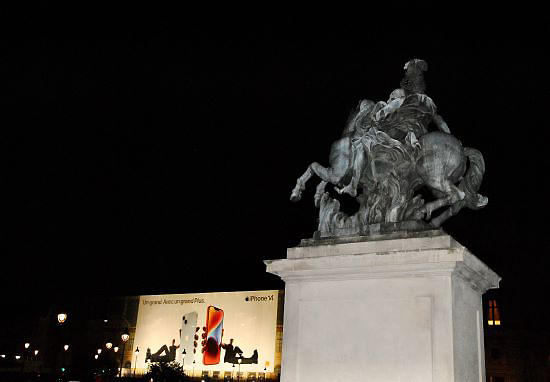MAIS ABSOLUMENT!
"We saw Notre-Dame, Versailles, the Sacré-Coeur, the Palais Garner, the Louvre...," an elegant, well-educated and very pleasant visitor said, glad to have experienced the celebrated sites in the usual way. That comment reminded me of how I too, an American historian who has lived in the city for decades, once took the classic view for granted.
These pages show a different city. They:
- Revisit some of the famous monuments and introduce others that are forgotten:
The Saint-Denis gate, which visitors have never heard of and whose meaning few Parisians recall.
- Show the kings as the core of French uniqueness and Parisian grandeur, rather than forgetting them or reducing them to anecdotes.
- Explore outskirts whose energy comes from (relatively) affordable rents and the presence of immigrants.
- Highlight the mid-19th century insurrections, which schoolbooks and the historical museum barely touch.
- Conclude with the 13th arrondissement (district), once the city's most miserable, where social services are now outstanding, the Asian neighborhood colorful and vibrant, revegetation and street art in full swing and unusual creativity encouraged.
I'm happy to present the little-known area where I've lived for 20 years.
The sequel, History from fresh perspectives, uses examples from from precolonial Africa and pre-industrial France to show how emphasis on underlying economies transforms our understanding of how things change.
# # #
TRAILERS
I.
THE OUTSKIRTS,
WHERE CREATIVITY BLOOMS
Paris harbors an immense number of artists in all domains, most of whom are foreign-born and live not in the places once associated with them (Saint-Germain, Montmartre, Montparnasse) but in the unsung periphery, where rents are lower. The painter whose drawings dot these pages, Harald Wolff, is an example: He is German and lives in Montreuil, a plebeian suburb of the city's far east.
Those outlying areas are where major cultural initiatives are often launched (for examples, please click here and here) and experiments tried (for a performance that made the streets the stage, click here).
La Goutte d'Or, a part-African neighborhood at the city's northern edge, embodies newcomer energy. It boasts an effervescent small-scale couture industry. And it is a cauldron for the sociable art of appearance — i.e., making one’s physical “look” a composition.
 |
Uncredited photos are mine.
|
Seen on rue Doudeauville, "Main Street"
Barbershop windows propose innumerable coiffures, by posters that are heirs of signs in African markets. When soccer players
adopted the cuts to be identified on television during the 2014 World Cup they immediately spread world wide.
Hair, beard and mustache styles have taken off in the Black barbershops ever since, the much rarer establishments in other neighborhoods timidly following.
"Art must reveal a philosophy. Otherwise it is just decoration," an art critic told me. The coiffures, beards and costumes express an upbeat affirmation of individual uniqueness, and the signs imply a context of a homogenous, supportive community.
Traditional shops reflect that philosophy. How the shops' offerings are presented does not matter since clients come because they know the vendors, and stay to keep them company. Good humor is omnipresent, and for an example of kindness when I least expected it, please click.
People support each other: that’s key to surviving in an often harsh European world.
II.
THE INSURRECTIONS:
MANY PEOPLE THINK THESE ICONIC FIGURES
ARE STORMING THE BASTILLE (IN 1789)...
Liberty Guides the People by Eugene Delacroix, 1830-1831 (cut) / zoom
In fact, the Revolution of 1830 inspired the work. Its three days of combat finished what the French Revolution had begun: eliminating nobles' power, which let capitalism take wing. That is almost never mentioned. Capitalism isn't either.
Insurrections were at the core of Parisian history for the next 40 years. They helped form our world, and much of the city's beauty comes from transformations meant to facilitate their repression. For a story that used to be taken for granted but now is almost never told, please click here, for how it is even more glossed over here and here, and for how that change is starting to be contested, here.
The last and most tragic upheaval led to the Paris Commune, when inexperienced young leaders whom humble people backed ran City Hall from March to May 1871.
Proclamation of La Commune, March 26 1871, anonymous engraving / zoom
In spite of war with the national government, a siege, and the flight of most seasoned administrators, they kept the continent's largest city (one million residents) running. They also sketched out a vision for a genuinely democratic society under workers' control.
"They failed because of their great decency" said Marx of these idealists. They did not touch the gold the fleeing government left, their nurses tended the wounded on both sides, and they used scarce revenues to succor widows whose men had died fighting them.
Their merciless repression foreshadows 20th-century calamities.
 |
A Versaillais Firing Squad during Bloody Week, by V. Sarday, reproduced by "Friends of the Paris Commune" / zoom
("Versaillais:" The regular government had fled to Versailles.) |
The victims' unyielding resistance in this later painting comes from illustrations of the time and from grudging respect even from adversaries.
La Commune still inspires the left...
 |
| Commemorative parade, 2021 |
# # #
This is a "blook" that, like a blog, uses the web to make its points briskly through headlines and pictures. The index, under the menu on the right, gives immediate access to the main ideas. Contents lets you click directly into specific pages. Epilogues suggests their wider relevance.
There's space for comments at the end of each page: I would love to know what you think. Political remarks are welcome.






.jpg)

_-_WGA6178.jpg)














.JPG)




.jpg)






.jpg)

.jpg)



